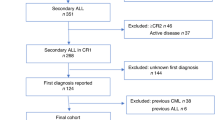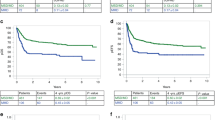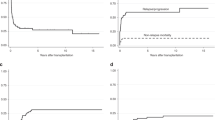Abstract
Fifty-four percent of adults with acute lymphoblastic leukemia (ALL) who entered the LALA-94 trial experienced a first relapse. We examined the outcome of these 421 adult patients. One hundred and eighty-seven patients (44%) achieved a second complete remission (CR). The median disease-free survival (DFS) was 5.2 months with a 5-year DFS at 12%. Factors predicting a better outcome after relapse were any transplant performed in second CR (P<0.0001), a first CR duration >1 year (P=0.04) and platelet level >100 × 109/l at relapse (P=0.04). Risk groups defined at diagnosis and treatment received in first CR did not influence the outcome after relapse. The best results were obtained in a subset of patients who were eligible for allogeneic stem cell transplantation (SCT). Geno-identical allogeneic SCT was performed in 55 patients, and 3 patients received donor lymphocyte infusions. Forty-four transplantations were performed from an unrelated donor (of which four were cord blood). We conclude that most adult patients with recurring ALL could not be rescued using current available therapies, although allogeneic SCT remains the best therapeutic option.
This is a preview of subscription content, access via your institution
Access options
Subscribe to this journal
Receive 12 print issues and online access
$259.00 per year
only $21.58 per issue
Buy this article
- Purchase on SpringerLink
- Instant access to full article PDF
Prices may be subject to local taxes which are calculated during checkout



Similar content being viewed by others
References
Durrant IJ, Prentice HG, Richards SM . Intensification of treatment for adults with acute lymphoblastic leukaemia: results of UK medical research council randomized trial UKALL XA. medical research council working party on leukaemia in adults. Br J Haematol 1997; 99: 84–92.
Fiere D, Lepage E, Sebban C, Boucheix C, Gisselbrecht C, Vernant JP et al. Adult acute lymphoblastic leukemia: a multicentric randomized trial testing bone marrow transplantation as postremission therapy. J Clin Oncol 1993; 11: 1990–2001.
Hoelzer D, Thiel E, Ludwig WD, Löffler H, Büchner T, Freund M et al. Follow-up of the first two successive German multicentre trials for adult ALL (01/81 and 02/84). Leukemia 1993; 7 (Suppl 2): S130–S134.
Larson RA, Dodge RK, Burns CP, Lee EJ, Stone RM, Schulman P et al. A five-drug remission induction regimen with intensive consolidation for adults with acute lymphoblastic leukemia: cancer and leukemia group B study 8811. Blood 1995; 85: 2025–2037.
Mandelli F, Annino L, Rotoli B, for the GIMEMA Cooperative Group. The GIMEMA ALL 0183 trial, analysis of 10-year follow-up. Br J Haematol 1996; 92: 663–672.
Kantarjian HM, O'Brien S, Smith TL, Cortes J, Giles FJ, Beran M et al. Results of treatment with Hyper-CVAD, a dose-intensive regimen, in adult acute lymphocytic leukemia. J Clin Oncol 2000; 18: 547–561.
Hoelzer D . Acute lymphoblastic leukemia: progress in children, less in adults. N Engl J Med 1993; 329: 1343–1344.
Bassan R, Lerede T, Barbui T . Strategies for the treatment of recurrent acute lymphoblastic leukemia in adults. Haematologica 1996; 81: 20–36.
Weiss MA . Treatment of adult patients with relapsed or refractory acute lymphoblastic leukemia (ALL). Leukemia 1997; 11 (Suppl 4): S28–S30.
Welborn J . Impact of re-induction regimens for relapsed and refractory acute lymphoblastic leukemia in adults. Am J Hematol 1994; 45: 341–344.
Garcia-Manero G, Thomas DA . Salvage therapy for refractory or relapsed acute lymphocytic leukemia. Hematol Oncol Clin North Am 2001; 15: 163–205.
Thomas X, Boiron JM, Huguet F, Dombret H, Bradstock K, Vey N et al. Outcome of treatment in adults with acute lymphoblastic leukemia: analysis of LALA-94 trial. J Clin Oncol 2004; 22: 4075–4086.
Dombret H, Gabert J, Boiron JM, Rigal-Huguet F, Blaise D, Thomas X et al. Outcome of treatment in adults with Philadelphia chromosome-positive acute lymphoblastic leukemia – results of the prospective multicenter LALA-94 trial. Blood 2002; 100: 2357–2366.
Bennett JM, Catovsky D, Daniel MT, Flandrin G, Galton DA, Gralnick HR et al. Proposals for the classification of the acute leukaemias. French–American–British (FAB) co-operative group. Br J Haematol 1976; 33: 451–458.
Kantarjian HM, Walters RS, Keating MJ, Barlogie B, McCredie KB, Freireich EJ . Experience with vincristine, doxorubicin, and dexamethasone (VAD) chemotherapy in adults with refractory acute lymphoblastic leukemia. Cancer 1989; 64: 16–22.
Schrappe M, Reiter A, Ludwig WD, Harbott J, Zimmermann M, Hiddemann W et al. Inproved outcome in childhood acute lymphoblastic leukemia despite reduced use of anthracyclines and cranial radiotherapy: results of trial ALL-BFM 90. German–Austrian–Swiss ALL–BFM study group. Blood 2000; 95: 3310–3322.
Schaison G, Auclerc MF, Baruchel A, Leblanc T, Leverger G . Prognosis of acute lymphoblastic leukemia in children. Results of the French protocol FRALLE 93. Bull Acad Natl Med 2001; 185: 149–160.
Capizzi RL, Keeser LW, Sartorelli AC . Combination chemotherapy: theory and practice. Semin Oncol 1977; 4: 227–253.
Milpied N, Gisselbrecht C, Harousseau JL, Sebban C, Witz F, Troussard X et al. Successful treatment of adult acute lymphoblastic leukemia after relapse with prednisone, intermediate-dose cytarabine, mitoxantrone, and etoposide (PAME) chemotherapy. Cancer 1990; 66: 627–631.
Arcese W, Meloni G, Giona F, Vegna ML, Testi AM, Annino L et al. Idarubicin plus ARA-C followed by allogeneic or autologous bone marrow transplantation in advanced acute lymphoblastic leukemia. Bone Marrow Transplant 1991; 7 (Suppl 2): 38.
Visani G, Tosi P, Zingani PL, Manfroi S, Ottaviani E, Cenacchi A et al. FLAG (fludarubicine, cytarabine, G-CSF) as a second line therapy for acute lymphoblastic leukemia with myeloid antigen expression: In vitro and in vivo effects. Eur J Haematol 1996; 56: 308–312.
Reman O, Buzyn A, Lhéritier V, Huguet F, Kuentz M, Stamatoullas A et al. Rescue therapy combining intermediate-dose cytarabine with amsacrine and etoposide in relapsed adult acute lymphoblastic leukemia. Hematol J 2004; 5: 123–129.
Arlin Z, Feldman E, Kempin S, Ahmed T, Mittelman A, Savona S et al. Amsacrine with high-dose cytarabine is highly effective therapy for refractory and relapsed acute lymphoblastic keukemia in adults. Blood 1988; 72: 433–435.
Thomas X, Bauduer F, Thiebaut A, Brion A, Maloisel F, Fenaux P et al. Idarubicin and ifosfamide in the treatment of refractory and relapsed acute lymphoblastic leukemia. In: Hiddemann W, Büchner T, Wörmann B, Ritter J, Creutzig U, Keating M, Plunkett W (eds). Acute Leukemias VII. Experimental approaches and novel therapies. Springer-Verlag: Berlin Heidelberg, 1998, pp 766–770.
Klein JP, Rizzo JD, Zhang MJ, Keiding N . Statistical methods for the analysis and presentation of the results of bone marrow transplants. Part I: Unadjusted analysis. Bone Marrow Transplant 2001; 28: 909–915.
Keating MJ, Holmes R, Lerner S, Ho DH . L-Asparaginase and PEG asparaginase – past, present, and future. Leuk Lymphoma 1993; 10 (Suppl): 153–157.
Kantarjian HM, Walters RS, Keating MJ, Barlogie B, McCredie KB, Freireich EJ . Experience with vincristine, doxorubicin, and dexamethasone (VAD) chemotherapy in adults with refractory acute lymphocytic leukemia. Cancer 1989; 64: 16–22.
Thomas DA, Kantarjian H, Smith TL, Koller C, Cortes J, O'Brien S et al. Primary refractory and relapsed adult acute lymphoblastic leukemia: characteristics, treatment results, and prognosis with salvage therapy. Cancer 1999; 86: 1216–1230.
Butturini A, Gale RP . Chemotherapy versus transplantation in acute leukaemia. Br J Haematol 1989; 72: 1–8.
Fielding AK, Richards SM, Chopra R, Lazarus HM, Litzow MR, Buck G et al. Outcome of 609 adults after relapse of acute lymphoblastic leukemia (ALL): an MRC UKALL12/ECOG 2993 study. Blood 2007; 109: 944–950.
George SL, Ochs JJ, Mauer AM, Simone JV . The importance of an isolated central nervous system relapse in children with acute lymphoblastic leukemia. J Clin Oncol 1985; 3: 776–781.
Herzig RH, Bortin MM, Barrett AJ, Blume KG, Gluckman E, Horowitz MM et al. Bone-marrow transplantation in high-risk acute lymphoblastic leukaemia in first and second remission. Lancet 1987; 1: 786–789.
Fleming DR, Henslee-Downey PJ, Romond EH, Harder EJ, Marciniak E, Munn RK et al. Allogeneic bone marrow transplantation with T cell-depleted partially matched related donors for advanced acute lymphoblastic leukemia in children and adults: a comparative matched cohort study. Bone Marrow Transplant 1996; 17: 917–922.
Davies SM, Ramsay NK, Weisdorf DJ . Feasibility and timing of unrelated donor identification for patients with ALL. Bone Marrow Transplant 1996; 17: 737–740.
Gluckman E, Rocha V, Boyer-Chammard A, Locatelli F, Arcese W, Pasquini R et al. Outcome of cord-blood transplantation from related and unrelated donors: Eurocord Transplant Group and the European Blood and Marrow Transplantation Group. N Engl J Med 1997; 337: 373–381.
Rubinstein P, Carrier C, Saradavou A, Kurtzberg J, Adamson J, Migliaccio AR et al. Outcomes among 562 recipients of placental-blood transplants from unrelated donors. N Engl J Med 1998; 339: 1565–1577.
Takeuchi J, Kyo T, Naito K, Sao H, Takahashi M, Miyawaki S et al. Induction therapy by frequent administration of doxorubicin with four other drugs, followed by intensive consolidation and maintenance therapy for adult acute lymphoblastic leukemia: the JALSG-ALL93 study. Leukemia 2002; 16: 1259–1266.
Ribera JM, Oriol A, Bethencourt C, Parody R, Hernandez-Rivas JM, Moreno MJ et al. Comparison of intensive chemotherapy, allogeneic or autologous stem cell transplantation as post-remission treatment for adult patients with high-risk acute lymphoblastic leukemia. Results of the PETHEMA ALL-93 trial. Haematologica 2005; 90: 1346–1356.
Labar B, Suciu S, Zittoun R, Muus P, Marie JP, Fillet G et al. Allogeneic stem cell transplantation in acute lymphoblastic leukemia and non Hodgkin's lymphoma for patents < or=50 years old in first complete remission: results of the EORTC ALL-3 trial. Haematologica 2004; 89: 809–817.
Sebban C, Lepage E, Vernant JP, Gluckman E, Attal M, Reiffers J et al. Allogeneic bone marrow transplantation in adult acute lymphoblastic leukemia in first complete remission: a comparative study. J Clin Oncol 1994; 12: 2580–2587.
Hunault M, Harousseau JL, Delain M, Truchan-Graczyk M, Cahn JY, Witz F et al. Better outcome of adult acute lymphoblastic leukemia after early genoidentical allogeneic bone marrow transplantation (BMT) than after late high-dose therapy and autologous BMT: a GOELAMS trial. Blood 2004; 104: 3028–3037.
Rowe J, Richards S, Burnett A, Wiernik PH, Harrison G, Lazarus HM et al. Favorable results of allogeneic bone marrow transplantation (BMT) for adult with Philadelphia (Ph)-chromosome-negative acute lymphoblastic leukemia (ALL) in first complete remission (CR): results from the International ALL trial (MRC UKALL XII/ECOG E2993). Blood 2001; 98 (Suppl 1): 2009.
Yanada M, Matsuo K, Suzuki T, Naoe T . Allogeneic hematopoietic stem cell transplantation as part of postremission therapy improves survival for adult patients with high-risk acute lymphoblastic leukemia. Cancer 2006; 106: 2657–2663.
Acknowledgements
We greatly thank Professor Charles Dumontet for proofreading this paper. This work was supported in part by PHRC no. 94-95-97.02, Ministère de l'Emploi et de la Solidarité, France.
Author information
Authors and Affiliations
Consortia
Corresponding author
Appendix
Appendix
The following hospitals participated in the LALA-94 trial:
Groupe d'Etude et de Traitement de la Leucémie Aiguë Lymphoblastique de l'Adulte (GET-LALA Group) – Hôpital Edouard Herriot, Lyon; Hôpital Saint-Louis, Paris; Hôpital du Haut Levêque, Pessac; Hôpital Purpan, Toulouse; Hôpital Henri Mondor, Créteil; Hôpital Pitié-Salpétrière, Paris; Institut Paoli Calmettes, Marseille; Hôpital Cochin, Paris; Hôpital de Hautepierre, Strasbourg; Hôpital de l'Archet, Nice; Hôpital Necker, Paris; Hôpital Jean Bernard, Poitiers; Hôpital Michallon, Grenoble; Institut Gustave Roussy, Villejuif; Hôpital du Bocage, Dijon; Hôpital Saint-Antoine, Paris; Centre Hospitalier, Caen; Hôpital Pontchaillou, Rennes; Centre Hospitalier de la Côte Basque, Bayonne; Centre Hospitalier Lyon-Sud, Pierre Bénite; HIA Percy, Clamart; Centre Hospitalier, Chambéry; Hôpital Dupuytren, Limoges; Centre Hospitalier, Avignon; Hôpital Louis Pasteur, Colmar; Centre Henri Becquerel, Rouen; Centre Hospitalier, Lille; Hôtel Dieu, Clermont-Ferrand; Hôpital André Mignot, Versailles; Hôpital Beaujon, Clichy; Centre Hospitalier, Annecy; Centre Hospitalier Lapeyronie, Montpellier; Centre Hospitalier, Aix en Provence; Hôpital Jean Monod, Le Havre; Hôpital Lariboisière, Paris; Hôpital Victor Dupouy, Argenteuil; Centre Hospitalier Dr Schaffner, Lens; Centre Antoine Lacassagne, Nice; Centre Hospitalier, Meaux; Centre Hospitalier, Perpignan; Clinique St Vincent, Lille; Centre Hospitalier, Nîmes; Centre Hospitalier, Roubaix, France.
Cliniques St Luc, Bruxelles; Centre Hospitalier Notre Dame et Reine Fabiola, Charleroi; Cliniques de Mont Godinne, Yvoir; ASBL, Loverval; Hôpital Saint Joseph, Gilly; Hôpital de Jolimont, Haine St Paul; Hôpital St Joseph, Mons; Hôpital de la Citadelle, Liège; Laboratoire de Cytogénétique, Leuven, Belgium.
Swiss Group for Clinical Cancer Research (SAKK) – Centre Hospitalier Universitaire Vaudois, Lausanne; Kantonsspital, St Gallen; Universitätsspital, Zürich; Hôpital Cantonal Universitaire, Genève; Kantonsspital, Basel; Inselspital, Bern; Kantonsspital, Winterthur; Kantonsspital, Luzern, Switzerland.
Australasian Leukaemia and Lymphoma Group (ALLG) – Westmead Hospital, Westmead; Adelaide Hospital, Adelaide; Mater Misericordae Hospital, Newcastle; Alfred Hospital, Melbourne; Royal Adelaide Hospital, Adelaide; Peter Mac Callum Cancer Centre Institute, Melbourne; Monash Medical Centre, Melbourne; Liverpool Hospital, Sydney; St George Hospital, Sydney, Australia.
Rights and permissions
About this article
Cite this article
Tavernier, E., Boiron, JM., Huguet, F. et al. Outcome of treatment after first relapse in adults with acute lymphoblastic leukemia initially treated by the LALA-94 trial. Leukemia 21, 1907–1914 (2007). https://doi.org/10.1038/sj.leu.2404824
Received:
Revised:
Accepted:
Published:
Issue Date:
DOI: https://doi.org/10.1038/sj.leu.2404824



